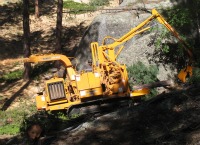
Bandit Industries debuts 1890 Track
November 11, 2010
By Bandit Industries
 |

|
Nov. 11, 2010 – Perched among the granite outcrops and
resolute presidents of Mount Rushmore, Bandit’s new model 1890 Track
self-propelled drum chipper is working to spruce up the national monument while
protecting the surrounding forests of the southern Black Hills. Compact in
size, highly maneuverable, and capable of impressive production rates, the 1890
Track is the perfect machine to tackle the thinning operation occurring within
the national park.
“Projects like this are exactly what we had in mind when we
decided to build a self-propelled version of our 1890,” says Jason Morey,
marketing manager for Bandit Industries. “It’s small enough to go pretty much
anywhere, and it’s strong enough to chip a surprising amount of wood for its
size.”
The original model 1890’s versatility in the field is taken
to the next level with a loader and a Caterpillar 307B steel-track
undercarriage. It rides on a pair of 500-mm pads, giving the 1890 exceptional
flotation over soft terrain and plenty of stability to scale steep slopes. A
built-in loader takes the hands out of this hand-fed chipper, allowing a single
operator to feed the machine with material up to 19 inches in diameter. A
standard radio control allows operators to handle all chipper functions
remotely, while an easy-to-use swing out control panel on the machine itself is
available for those preferring direct contact. Engine options range from 114 to
213 hp, and a swivel discharge allows chips to be broadcast where they’re
needed.
The extent of the 1890 Track’s versatility is being put to
the test in South Dakota, where its ability to scale tricky terrain and climb
mountains is assisting the National Park Service in thinning the woods around
Mount Rushmore. The three-month project is designed to make the park and
surrounding forests more resistant to fire by removing younger trees less than
10 inches in diameter. The measure will also serve to slow the pine beetle
infestation that has affected the area. To preserve the integrity of the forest
and area wildlife, tight restrictions are in place to ensure the project only
removes that which is necessary.
“It’s not logging or clear cutting,” says Mike Johnson, the
park service regional fire information officer. “It’s thinning out some of the
stuff that would’ve burned in a natural forest cycle.”
The goal of the project is to develop a diverse ecosystem
similar to what existed in the area approximately 100 years ago. As material is
processed, the chips are spread back over the forest floor to keep nutrients in
the park, sustaining a very natural feel. The ability of the 1890 Track to
traverse jagged rocks on precarious slopes, process trees and brush, and blanket
the chips over the ground makes it the ideal machine to handle such a project.
Print this page